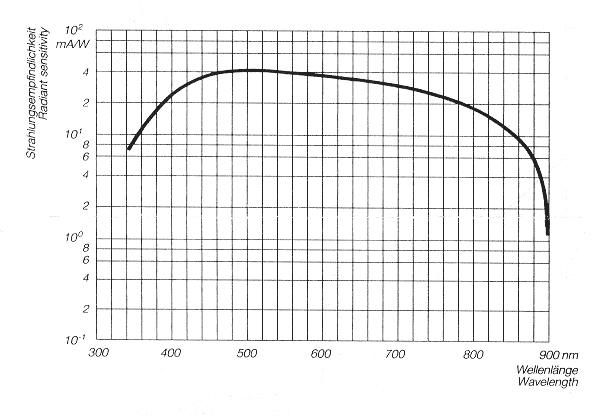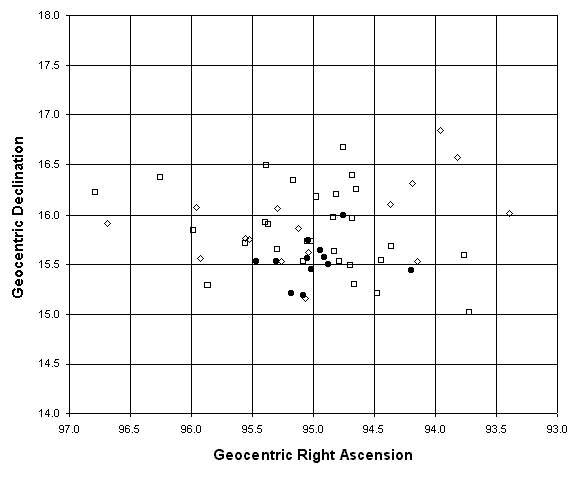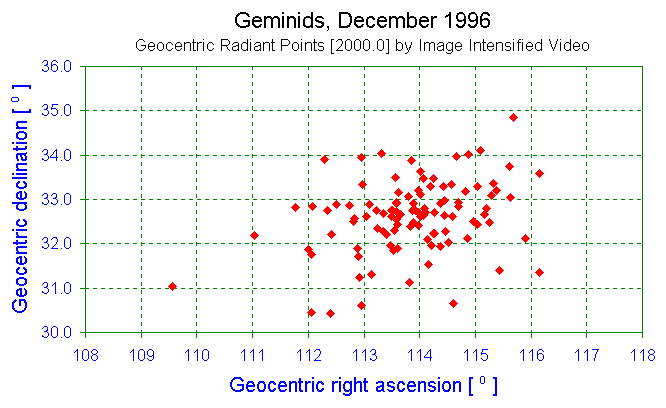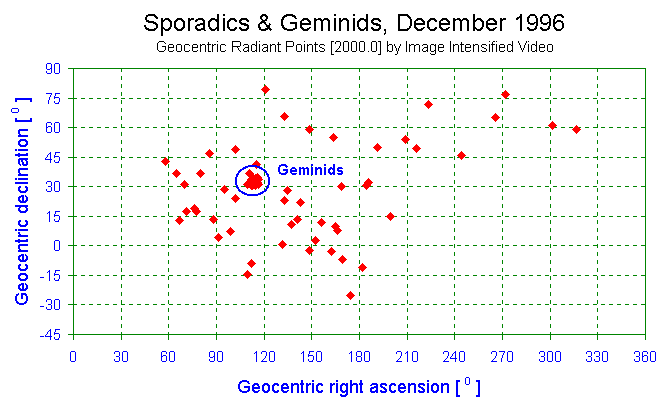|
|
Marc de Lignie An overview of the DMS observations with image intensified videosystems is presented. Double-station video results such as orbital elements and trajectory data are maintained on our DMS ftp-site and are ready for download. |
DMS Video Observations and Results
Within DMS video observations started around 1987. Active members in this field are: Klaas Jobse, Hans Betlem, Romke Schievink, Carl Johannink, Jan Boonstra, Casper ter Kuile and Marc de Lignie. The video cameras used are typically equipped with an F/1.2-55 mm photographic objective, a Hi8 camcorder and military image intensifying electronics (see below). Such a camera records stars up to magnitude +8 and meteors up to magnitude +7 in a 25 degrees field of view. The mass range in detected meteors is thus distinctly different compared to photographic observations and observations are worthwhile even with low hourly rates of a certain stream.
The AEG XX1400 Microchannel Image Intensifier Tube used at station Biddinghuizen. Some general characteristics:
|
 |

DMS Video Observations and Results
DMS has focussed their efforts exclusively on double-station observations and in some cases meteors were even recorded by three cameras simultaneously. Such observations are more selective than single station observations; this selectivity is particularly useful for minor showers and for shower outbursts.
The first step in the data reduction is to prepare a list of meteors that appeared in the video cameras at two or more stations. Then the meteor images are digitized with a frame grabber, so that they become accessible for computer measurements. Within DMS this astrometrical reduction is done with the AstroRecord computer program. As a final step the atmospheric trajectory and the heliocentric orbit are calculated for the meteor. The video double-station events recorded by DMS are measured with an accuracy of 45 arc seconds. This is only a factor four less accurate than for good quality photographic negatives.
 |
The picture on the left shows the measurement window of the AstroRecord software developed by Marc de Lignie. Note the blue colored measurement points of the breaks of the meteor trail. At the right the equatorial coordinates of the measurement point are given. These are computed after measuring a number of stars. |
In the amateur meteor world DMS pioneered the field of video registration techniques with observations dating back as far as 1987. Although these observations made immediately apparent the enormous possibilities of video observations, at that time the computer technology accessible to amateurs was not suitable to reduce the video images. As a result it took six years to develop the necessary software and publish the first astronomically significant results in 1993. Since that time, results from video observing campaigns by DMS have been published on a regular basis.
DMS Video Observations and Results
The table below gives a complete overview of the published double-station video results by DMS. With 248 major shower members and 38 minor shower members the sample gives a good overview of stream activity in the northern hemisphere. The results can be downloaded in the form of a table with orbital elements and trajectory data from the DMS FTP-site as a plain text file or as an Microsoft Excel file.
| Observing campaign | Major showers | Minor showers | Spo | Total | Publication |
|---|---|---|---|---|---|
| Geminids 1991 | 2 Geminids | 1 Chi Orionid | 2 | 5 | Radiant 1993:3 |
| Kappa Cygnids 1993 | 5 Kappa Cygnids 7 Perseids 1 N Delta Aquarid 1 S Delta Aquarid 1 Capricornid |
2 N Iota Aquarids 2 ?? Aquarids 2 Aurigids |
39 | 60 | WGN 1997:3 |
| Orionids 1993 | 17 Orionids 2 N Taurids 3 S Taurids |
1 Epsilon Geminid | 35 | 58 | Radiant 1995:5 |
| Quadrantids 1995 | 29 Quadrantids | - | 20 | 49 | WGN 1996:1 A&A 327 (1997) 1242-52 |
| Orionids 1995 | 32 Orionids 4 S Taurids |
3 Leo Minorids | 28 | 67 | Radiant 1999:2 WGN 1999:3/4 |
| Leonids 1995 | 13 Leonids 8 Alpha Monocerotids 10 N Taurids 8 S Taurids |
4 b-Leonids 4 N Delta Arietids 6 Ksi Orionids |
136 | 189 | Ap. J. 479 (1997) 441-7 Radiant 1997:4 |
| Lyrids 1996 | 3 Lyrids | 1 Sagitarid | 3 | 7 | Radiant 1997:1 |
| Geminids 1996 | 102 Geminids | 3 Coma Berenicids 2 Chi Orionids 2 Monocerotids 3 Beta Leo Minorids 2 Sigma Hydrusids |
51 | 165 | Radiant 1997:6 Radiant 1998:3 |
| Perseids 1997 (USA) | - | - | 6 | 6 | Submitted to Radiant |
| Perseids 1998 | 3 Perseids 1 S Delta Aquarid |
2 N Iota Aquarids | 17 | 23 | Submitted to Radiant |
| Total | 252 | 40 | 337 | 629 | 13 publications |
DMS Video Observations and Results
| Observing campaign | No. meteors | Status |
|---|---|---|
| Perseids 1994 | about 20 | to be started |
| Aquarids 1995 | about 50 | to be started |
| Perseids 1997 (USA) | 35 Perseids | all orbits calculated |
| Ursids 1997 (USA) | 13 Ursids 17 sporadics |
all orbits calculated |
| Draconids 1998 (USA) | 3 Draconids | all orbits calculated |
| Leonids 1998 (Delingha) | 24 Leonids 6 Taurids 28 sporadics 1 Alpha Monocerotid 1 S Delta Arietid 1 b Leonid |
all orbits calculated |
| Leonids 1998 (Xinglong) | about 150 | measurements started |
DMS Video Observations and Results
Double-station video observations in The Netherlands on October 21/22, 1995, resulted in 67 orbits among which 32 Orionids, 4 Southern Taurids and 3 Leo Minorids. The corresponding derived shower activities in the form of "video ZHRs" are given in the table below.
| Shower | Ori | S-Tau | N-Tau | Eps Gem | LMi |
|---|---|---|---|---|---|
| N | 32 | 4 | 0 | 0 | 3 |
| VHZR | 16 | 2.0 | 0 | 0 | 1.1 |
By combining the video samples of 1993 and 1995, a larger sample of Orionid data is obtained than the sample of photographic data in the IAU database. For even greater accuracy also the photographic Orionids of the DMS photographic database were added. This results in very accurate values of radiant motion and a detailed figure of the radiant area (see below). It is clearly visible that the width of the radiant increases for smaller particles (those observed by video). This is a real effect, because the uncertainty in the video observations is smaller than the width of the radiant area.
RAg = 94.99 + (+0.90 ± 0.07) x (sol. long. - 208.00) DEg = 15.80 + (+0.10 ± 0.04) x (sol. long. - 208.00)

Sixty-one Orionid radiant points (J2000.0) moved to solar longitude 208.00, using the radiant motion given above. The squares are the new video data, the diamonds are the old video data from 1993 and the circles come from the DMS photographic database.
As in other video samples around 20 October, the Epsilon Geminids are not present and it is concluded that the activity of this shower must be lower than currently believed from visual observations. On the other hand, the Leo Minorids were clearly present and new values for their orbit and radiant position and motion could be determined, see the tables below.
RAg = 159.95 + (+0.96 ± 0.15) x (sol. long. - 209.00) DEg = 36.78 + (+0.08 ± 0.24) x (sol. long. - 209.00)
Orbital elements and radiants (J2000.0) of the known high precision Leo Minorids.
| Source | n | q | a | e | i | omega | node | Vg | RAg | DEg |
|---|---|---|---|---|---|---|---|---|---|---|
| Photo DMS+IAU | 4 | 0.641 | 33.6 | 0.985 | 124.5 | 106.3 | 209.9 | 61.8 | 160.7 | 37.2 |
| Video DMS | 3 | 0.607 | 58.1 | 0.989 | 125.9 | 102.4 | 208.3 | 62.0 | 159.5 | 36.2 |
| Overall average | 7 | 0.627 | 41.0 | 0.987 | 125.1 | 104.6 | 209.2 | 61.9 | 160.2 | 36.8 |
DMS Video Observations and Results
During one night around the 1996 Geminid maximum 165 (!) meteors were observed simultaneously by intensified video systems. The Geminids are a welcome addition to the available orbital material.

Figure 1: Geocentric radiant positions (2000.0) of 102 Geminid meteors recorded during the Geminid maximum 1996 by means of image intensified video cameras operated from Leidschendam (Marc de Lignie), Varsseveld (Hans Betlem) and Biddinghuizen (Casper ter Kuile).

Figure 2: Geocentric radiant positions (2000.0) of 51 sporadic, 102 Geminid, 3 Coma Berenicid, 2 Chi Orionid, 2 December Monocerotid, 3 Beta Leo Minorid and 2 Sigma Hydrusid meteors recorded during the Geminid maximum 1996 by means of image intensified video cameras operated from Leidschendam (Marc de Lignie), Varsseveld (Hans Betlem) and Biddinghuizen (Casper ter Kuile).
DMS Video Observations and Results
- Orbits : visualisation of orbital elements (by Marc de Lignie)
- Video Observation of Meteors, International Meteor Organization (IMO)
- Video Observations of Meteors: History, Current Status and Future Prospects from Sirko Molau, Mirko Nitschke, Marc de Lignie, Robert L. Hawkes and Jürgen Rendtel
- Video Observations and Results in 1995/96 from Sirko Molau
- The SIV Project - introduction and contents from Detlef Koschny (MPI/ESA)
- Television Meteors IAU Commission 22, R.L. Hawkes
- Ed Majden (spectra web page)